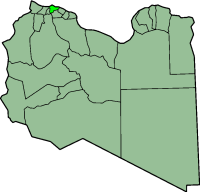Tripoli
|
|
- For other uses, see Tripoli (disambiguation).
Tripoli (population 1.5 million, Arabic: طرابلس Ṭarābulus) is the capital of Libya. The city is located in the northwest of the country; it lies on the edge of the desert, on a point of rocky land projecting into the Mediterranean Sea and forming a bay. The city was founded in the 7th century BC by the Phoenicians, who named it Oea. Tripoli is located at 32°54'8" North, 13°11'9" East (32.90222, 13.185833). [1] (http://earth-info.nga.mil/gns/html/cntry_files.html)
Tripoli is the largest city, the principal sea port, and the largest commercial and manufactuing centre in Libya. It is also the seat of the national government and the site of Al-Fateh University. Due to the cities long history there are many sites of archeological significance in Tripoli.
The city was subjected to air strike by the United States in 1986, in retaliation for alleged Libyan support of terrorism. United Nations sanctions against Libya were lifted in 2003, which is expected to increase traffic through the Port of Tripoli and have a positive impact on the city's economy.
| Contents |
Geography
Tripoli, a large modern seaport, is located in the northwest of Libya on the Mediterranean coast. The climate is typical Mediterranean, with hot dry summers, cool winters, and some modest rainfall.
History
Foundation
The city was founded in the 7th century BC by the Phoenicians, who named it Oea. From the Phoenicians Tripoli passed into the hands of the rulers of Cyrenaica (Barca), from whom it was wrested by the Carthaginians. It next belonged to the Romans, who included it within the province of Africa, and gave it the name of Regio Syrtica. About the beginning of the 3rd century A.D. it became known as the Regio Tripolitana (on account of its three principal cities, Oea, Sabrata, and Leptis, which were leagued together), and was probably raised to the rank of a separate province by Septimius Severus, who was a native of Leptis. Like the rest of North Africa, it was conquered by the Muslims early in the 8th century.
The Ottoman province (vilayet) of Tripoli (including the dependent sanjak of Cyrenaica) lay along the southern shore of the Mediterranean Sea between Tunisia in the west and Egypt in the east. Besides the city itself, the area included Cyrenaica (the Barca plateau), the chain of oases in the Aujila depression, Fezzan, and the oases of Ghadames and Ghat, separated by sandy and stony wastelands.
In 1510 it was taken by Don Pedro Navarro for Spain, and in 1523 it was assigned to the Knights of St. John, who had lately been expelled by the Ottoman Turks from their stronghold in the island of Rhodes. The knights kept it with some trouble till 1551, when they were compelled to surrender to the Turkish admiral Sinan, and Tripoli henceforward joined in the general piracy which made the Barbary states the terror of maritime Christendom.
In 1714 the ruling pasha, Ahmed Karamanli, assumed the title of bey, and asserted a sort of semi-independence of the Sultan, and this order of things continued under the rule of his descendants, accompanied by the most brazen piracy and blackmailing, till 1835, when the Ottoman Empire ("the Porte") took advantage of an internal struggle in Tripoli to reassert its authority. A new Turkish pasha, with vice-regal powers, was appointed and the state was made a vilayet of the Ottoman empire.
Tripoli War
In the early part of the 19th century the regency at Tripoli, owing to its piratical practices, was twice involved in war with the United States. In May 1801 the pasha demanded from the United States an increase in the tribute ($83,000) which the U.S. government had been paying since 1796 for the protection of their commerce from piracy. The demand was refused, and a naval force was sent from the United States to blockade Tripoli. The war dragged on for four years, the Americans in 1803 losing the frigate, Philadelphia, the commander (Captain William Bainbridge) and the whole crew being made prisoners. The most picturesque incident in the war was the expedition undertaken by William Eaton with the object of replacing the pasha with an elder brother living in exile, who had promised to accede to all the wishes of the United States. Eaton at the head of a motley assembly of 500 men marched across the desert from Alexandria, and with the aid of American ships succeeded in capturing Derna. Soon afterwards (June 3, 1805) peace was concluded, the reigning pasha relinquishing his demands but receiving $60,000 as ransom for the Philadelphia prisoners. In 1815, in consequence of further outrages, Captains Bainbridge and Stephen Decatur, at the head of an American squadron, again visited Tripoli and forced the pasha to comply with the demands of the United States.
In 1835 the Turks took advantage of a local civil war to reassert their direct authority, and after that date Tripoli was under the direct control of the Sublime Porte, rebellions in 1842 and 1844 being unsuccessful. After the occupation of Tunisia by the French (1881), the Turks increased their garrison in Tripoli considerably.
Italy had long claimed that Tripoli fell within her zone of influence and that she had the right to preserve order within the state. Under the pretext of protecting its own citizens living in Tripoli from the Turkish Government, Italy, on September 29, 1911, declared war against Turkey and announced her intention of annexing Tripoli. On October 1 1911, a naval battle was fought at Prevesa, European Turkey, and three Turkish vessels were destroyed. By the Treaty of Lausanne, Italian sovereignty was acknowledged by Turkey, although the Caliph was permitted to exercise religious authority.
Tripoli was controlled by Italy until 1943, then occupied by British forces until independence in 1951.
References
- Includes text from Collier's New Encyclopedia (1921).ar:طرابلس
bg:Триполи de:Tripolis eo:Tripolo (Libio) fa:طرابلس fr:Tripoli he:טריפולי (לוב) ja:トリポリ (リビア) nl:Tripoli (Libië) pt:Trípoli ru:Триполи fi:Tripoli sv:Tripoli

